All Quiet on the Western Front Blu-ray Movie
HomeAll Quiet on the Western Front Blu-ray Movie 
Universal 100th Anniversary | Collector's Edition | Includes Silent cut in SD / Blu-ray + DVD + Digital CopyUniversal Studios | 1930 | 133 min | Not rated | Feb 14, 2012
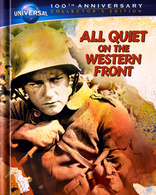
Movie rating
8.1 | / 10 |
Blu-ray rating
| Users | 4.5 | |
| Reviewer | 4.0 | |
| Overall | 4.0 |
Overview
All Quiet on the Western Front (1930)
Story of young German recruits in World War I, through their passage from idealism to disillusionment.
Starring: Louis Wolheim, Lew Ayres, John Wray, Arnold Lucy, Ben Alexander (I)Director: Lewis Milestone
| Drama | Uncertain |
| War | Uncertain |
| History | Uncertain |
| Action | Uncertain |
Specifications
Video
Video codec: MPEG-4 AVC
Video resolution: 1080p
Aspect ratio: 1.37:1
Original aspect ratio: 1.2:1
Audio
English: DTS-HD Master Audio 2.0 Mono (48kHz, 24-bit)
Subtitles
English SDH, French, Spanish
Discs
50GB Blu-ray Disc
Two-disc set (1 BD, 1 DVD)
Digital copy (as download)
DVD copy
BD-Live
D-Box
Mobile features
Playback
Region free
Review
Rating summary
| Movie | 4.5 | |
| Video | 4.0 | |
| Audio | 3.5 | |
| Extras | 2.5 | |
| Overall | 4.0 |
All Quiet on the Western Front Blu-ray Movie Review
War is hell, but this new Blu-ray is heavenly.
Reviewed by Jeffrey Kauffman February 2, 2012It may as something of a surprise to younger folks who are virulently anti-war and who currently protest against conflicts in Iraq and Afghanistan, but anti-war movements are probably as old as war itself. Many probably associate the idea of “anti-war protest” with the Vietnam War, since that seemed to be the movement that first raised the issue to huge, nightly news consciousness. But even that formulation seemingly forgets an earlier generation’s epochal conflict—World War II—and famous anti-war spokespeople like Charles Lindbergh, or (in a different, and perhaps not applicable, way) Neville Chamberlain. Younger kids especially have probably never even heard of All Quiet on the Western Front in either its original novel form or its first film adaptation from 1930, but in its day, the property was as iconic as anything out there in mass media. Author Erich Maria Remarque (that odd middle name was a self-chosen homage to his mother) had been drafted into the German Army during World War I, where he indeed was sent to the Western Front, was badly injured, and then was returned home. It took Remarque several years to establish his literary career, and in fact many publishers rejected All Quiet on the Western Front, but once the book did appear in 1928 and 1929 (first as a newspaper serial and then in novel form), it was an instant sensation. The book’s anti-war sentiment proved to be problematic for the Nazi regime which would soon sweep into power in Germany, and Remarque’s book were banned by Josef Goebbels. There was in fact a spurious propaganda war against Remarque by the Nazis, who insisted that his “decadent” views were the result of him coming from Jewish ancestry, something for which there is absolutely no evidence whatsoever. But in 1929, anyway, Remarque was a hot property and Hollywood came calling rather quickly, with the Universal film written (including by Broadway legend George Abbott, believe it or not), shot and in theaters not much more than a year later. The film, much like the book, was an instant sensation, ending up winning the Best Picture Oscar (the first non-musical talkie to secure that award) and becoming one of the most legendary motion pictures of the early talkie era.
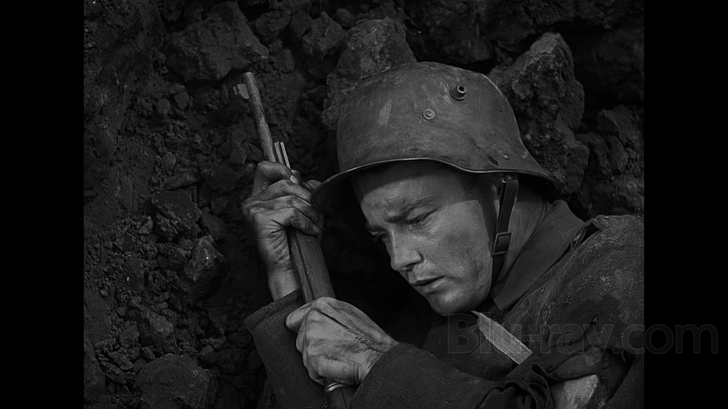
All Quiet on the Western Front is a remarkably prescient film from any number of standpoints. The film begins with a rabble rousing teacher who proselytizes his students about the supposed glories of war, convincing several of them to immediately enlist in an effort to defend the Fatherland. This group of young recruits is starry eyed for about a collective nanosecond before their rude awakening is exacerbated first by their training Commander, Himmelstoss (John Wray), their town’s former postmaster, who attempts to whip them into some sort of shape in a rather martinet manner. The recruits are basically schooled only in how to line up and march in formation before they’re told they’re off to the front. That leads to one of the most harrowing sequences in the film, when the group of young men arrives at what can only be termed Hell on Earth, a rain drenched nightmare of chaotic gunfire, shells exploding, panicked horses and general bedlam. Director Lewis Milestone stages this all with some incredible technical prowess, especially considering the limitations of the early talkie production methods. It’s worth noting how often Milestone utilizes tracking shots and a fluid, moving camera, something distinctly at odds with the “point and shoot” ethos that was de rigeur in those days when capturing sound was a technical nightmare. Notice, too, Milestone's excellent use of montage, albeit sometimes rather briefly, including a fantastic sequence late in the film where we follow several "owners" of a pair of elegant boots that pass from one soldier to the next as each meets their fate.
All Quiet on the Western Front is also much more of an ensemble piece than was the standard in those star based days, with a group of really measured and nuanced performances by a coterie of young actors portraying the recruits thrust into the madness of battle. While not necessarily the chief character, or in fact even the first billed in terms of star wattage, quite a bit of the emotional content of the film revolves around Paul Bäumer (Lew Ayres in one of his first major roles), a young man whose idealism is tested over and over again as the film progresses, including an incredibly harrowing sequence late in the film where the young soldier knifes a French fighter to death but is then trapped in a foxhole with the corpse for a night. The film’s iconic final moment (which won’t be spoiled here for those who haven’t yet seen it) also falls to Paul, and remains one of the most moving metaphors for the timeless quest for peace and beauty within the ravages Man seems to always bring upon himself that has ever been caught on celluloid.
The thirties are often thought of as a decade of escapism, at least in terms of the film industry. This was the time of the first big musicals, the silly romantic comedies and the paper thin dramas, at least in the first years of the decade, when talkies were still a newfangled contraption and people were struggling to overcome the horrors of the Depression. It’s almost unbelievable that a film as harrowing and visceral as All Quiet on the Western Front could have been produced as early as 1930, and it’s a lasting testament to the vision of producer Carl Laemmle and the technical mastery of director of Lewis Milestone (who won an Oscar for his work). What’s especially impressive about this film is how it really doesn’t feel all that dated, aside from a few tangential issues, most of which have to do with that era's more declamatory, theatrical acting style, which may strike younger viewers as being unnatural (which, frankly, it probably is). But far outweighing these concerns is the fact that over and over again this film delivers gut wrenching moments that bring the horrors of war fully home to the audience. While this shock value may indeed have been higher in the thirties, the fact that it still packs such a wallop after decades of audiences being exposed to everything from The Sands of Iwo Jima to The Longest Day to Patton to Apocalypse Now to Platoon speaks volumes about how profound an achievement All Quiet on the Western Front really is.
All Quiet on the Western Front Blu-ray Movie, Video Quality 
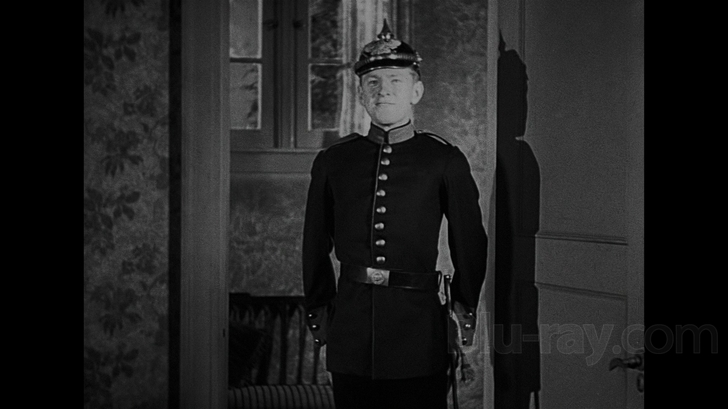
Let the Universal catalog title bashing games begin! Those who didn't like my recent review of To Kill a Mockingbird may very well be similarly
outraged by this assessment, so if you're in that camp and have blood pressure problems, you may want to skip this
section. (I jest, of course). All Quiet on the Western Front is presented on Blu-ray with an AVC encoded 1080p
transfer in 1.37:1 and the results for the most part are absolutely stunning. This film underwent significant restoration to
deal with a huge number of issues, including scratches, tears and perhaps most significantly horrible flicker which was so
prevalent it was almost seizure inducing. For anyone who has seen this film projected theatrically (as I have) or owned
previous home video releases (as I have), the results here are nothing less than revelatory. While there are still several
quite noticeable instances of damage (including a fairly long several second scratch that runs down the left side of the
frame in one sequence, which I was frankly surprised they didn't remove), overall this presentation is blemish free, at least
relatively speaking. But what a change in flicker and contrast! Has the film been digitally manipulated? Absolutely. But
watching this film now with a stable level of light and contrast brings out all sorts of new detail and makes the viewing
experience manifestly more pleasurable. There is one relatively major complaint I have with regard to the DNR and other
digital tools employed here. On scenes with largely white backgrounds, the grain is somewhat "frozen" looking, adding to a
slightly unreal ambience. Things are not waxy or smeared in any way, but this one element may bother even those who,
like me, aren't overly concerned with judiciously utilized digital tools. While these screencaps show that digital sharpening was utilized (as it
no doubt needed to be considering the age and condition of the elements), the haloing is really rather negligible when actually watching the
film.
A couple of anomalies should be noted about this Universal release. First off, this is the first Universal release that I can remember, catalog or
otherwise, that does not have a Main Menu. Instead the film simply starts and you must press the Pop-Up Menu to get other choices. Also,
the disc I received did not load the Chapters Menu properly. Pressing Chapters did bring up a supposed Chapters submenu, but there was
nothing there, i.e., no still frames of chapters to choose, simply the heading "Chapters". It is still possible to toggle through the chapters by
pressing the Skip Ahead button on your remote.
All Quiet on the Western Front Blu-ray Movie, Audio Quality 
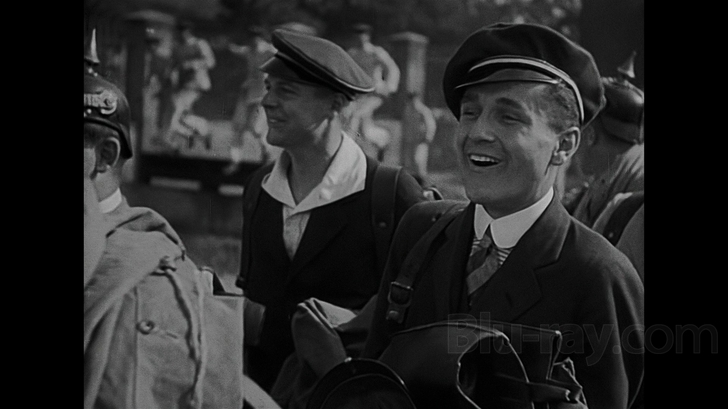
All Quiet on the Western Front's original mono soundtrack is presented here in a lossless DTS-HD Master Audio 2.0 format and if expectations are appropriately placed, few should have any major complaints about the results. This is one of the first talkies, obviously, and sound recording was in its infancy, and the technical limitations of the technology back then is quite evident throughout the track. Hiss is constant and consistent, burying some of the high end and the entire track has the boxed in, tinny sound that is so prevalent in all of these early talkies. That said, fidelity here is really rather good, taken within its proper historical context. Almost all of the outright age related damage to this track, in the form of pops, cracks and other audio "scratches," has been virtually eliminated and the track sounds like it's been reequalized with quite good results. Midrange is best here, and frankly the low end is almost nonexistent, giving the many explosions the sound more of firecrackers than of shells going off, but considering the age and primitive recording techniques utilized, this track really sounds amazingly spry.
All Quiet on the Western Front Blu-ray Movie, Special Features and Extras 
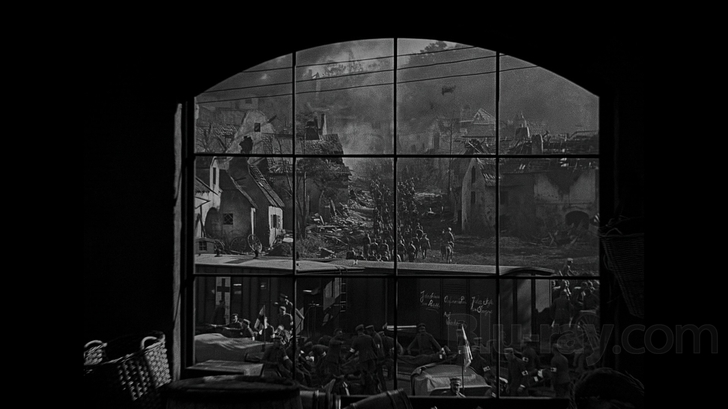
- All Quiet on the Western Front Silent Version (SD; 2:12:54). Just as theaters nowadays are transitioning between 2D and 3D product, 1930 saw a similar technological breakthrough with the advent of sound, except not all theaters were equipped to show talkies. A silent version of All Quiet on the Western Front was therefore also released, with interstitial title cards and several different edits in various scenes. This is an archival print from the Library of Congress, and while it's in acceptable shape, it's nowhere near the quality of the main feature here.
- Theatrical Trailer (SD; 2:30) is a reissue trailer
- 100 Years of Universal: Restoring the Classics (HD: 9:14) is the same featurette included on the recent To Kill a Mockingbird release (and one assumes will continue to be included with the rest of the 100th Anniversary releases coming this year). There is some fascinating footage included here showing flicker reduction on All Quiet on the Western Front.
- 100 Years of Universal: Academy Award Winners (HD; 9:35). This is another featurette concentrating on some of the Universal releases which have won various Academy Awards, several of which are being released this year as part of the 100th Anniversary celebration.
- Introduction by Turner Classic Movies Host and Film Historian Robert Osborne (SD; 2:40). Osborne offers some brief and not especially memorable comments which focus on Lew Ayres.
All Quiet on the Western Front Blu-ray Movie, Overall Score and Recommendation 
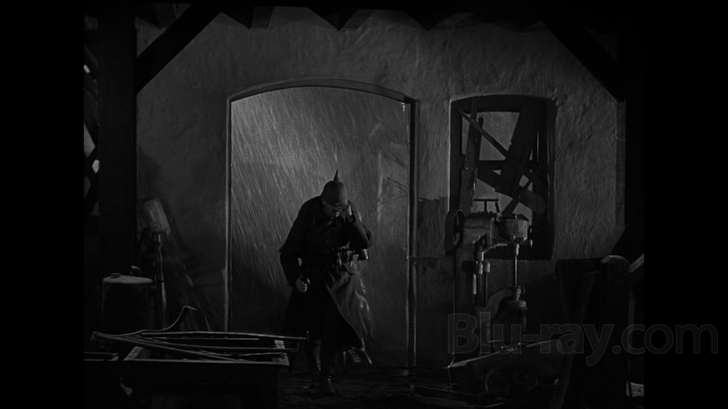
All Quiet on the Western Front has lost little if any of its impact now some 80-plus years after its original release. Is the film dated? Inarguably, especially with regard to some of the overly "indicating" acting styles, but that is a fairly minor qualm when thrust up against this film's towering achievement. Rarely have the horrors of war been so brutally and (as strange as this may sound) poetically rendered. When the film was released, a famous review stated that the League of Nations should dub the film into all available languages and show it in all nations until the word "war" had been erased from the dictionaries. That may sound like hyperbole, but it gives some indication of just how powerful All Quiet on the Western Front really is. Universal has done some spectacular restoration work on this title. Is it perfect? No, but it's darned close, certainly the best I've ever seen this title look and sound. Supplements are a little light on this release (why not a commentary for a film this iconic?), but otherwise this is another "must have" title for any serious collector. Highly recommended.
Other editions
All Quiet on the Western Front: Other Editions

All Quiet on the Western Front
Includes Silent cut in SD
1930

All Quiet on the Western Front
Includes Silent cut in SD
1930
Similar titles
Similar titles you might also like

Wings
1927

Paths of Glory
1957

The Longest Day
1962

Breaker Morant
1980

Full Metal Jacket 4K
Rerelease
1987

A Bridge Too Far
1977

Flags of Our Fathers
2-Disc Special Edition
2006

Das Boot
The Director's Cut | Single-Disc Edition
1981

Overlord
1975

The Bridge on the River Kwai
1957

Zulu
1964

Cross of Iron
1977

Platoon 4K
Collector's Edition
1986

The Lighthorsemen
1987

Dunkirk 4K
2017

9th Company
9 rota | Collector's Edition
2005

The Guns of Navarone
1961

The Thin Red Line
1998

The Big Parade
Warner Archive Collection
1925

Black Hawk Down 4K
2001